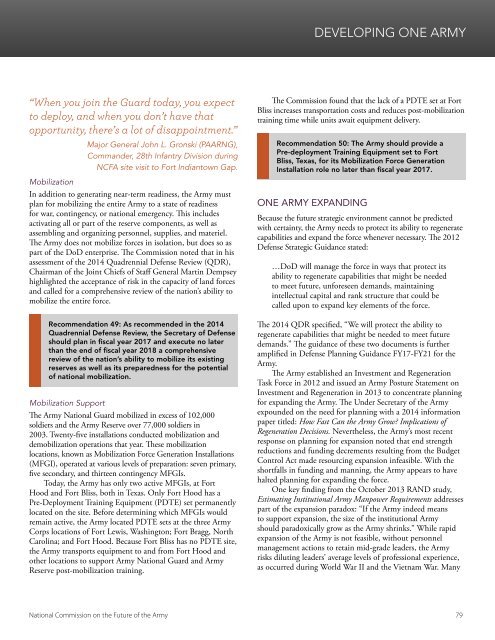THE FUTURE OF THE ARMY
Futurearmy
Futurearmy
You also want an ePaper? Increase the reach of your titles
YUMPU automatically turns print PDFs into web optimized ePapers that Google loves.
DEVELOPING ONE <strong>ARMY</strong><br />
“When you join the Guard today, you expect<br />
to deploy, and when you don’t have that<br />
opportunity, there’s a lot of disappointment.”<br />
Major General John L. Gronski (PAARNG),<br />
Commander, 28th Infantry Division during<br />
NCFA site visit to Fort Indiantown Gap.<br />
Mobilization<br />
In addition to generating near-term readiness, the Army must<br />
plan for mobilizing the entire Army to a state of readiness<br />
for war, contingency, or national emergency. This includes<br />
activating all or part of the reserve components, as well as<br />
assembling and organizing personnel, supplies, and materiel.<br />
The Army does not mobilize forces in isolation, but does so as<br />
part of the DoD enterprise. The Commission noted that in his<br />
assessment of the 2014 Quadrennial Defense Review (QDR),<br />
Chairman of the Joint Chiefs of Staff General Martin Dempsey<br />
highlighted the acceptance of risk in the capacity of land forces<br />
and called for a comprehensive review of the nation’s ability to<br />
mobilize the entire force.<br />
Recommendation 49: As recommended in the 2014<br />
Quadrennial Defense Review, the Secretary of Defense<br />
should plan in fiscal year 2017 and execute no later<br />
than the end of fiscal year 2018 a comprehensive<br />
review of the nation’s ability to mobilize its existing<br />
reserves as well as its preparedness for the potential<br />
of national mobilization.<br />
Mobilization Support<br />
The Army National Guard mobilized in excess of 102,000<br />
soldiers and the Army Reserve over 77,000 soldiers in<br />
2003. Twenty-five installations conducted mobilization and<br />
demobilization operations that year. These mobilization<br />
locations, known as Mobilization Force Generation Installations<br />
(MFGI), operated at various levels of preparation: seven primary,<br />
five secondary, and thirteen contingency MFGIs.<br />
Today, the Army has only two active MFGIs, at Fort<br />
Hood and Fort Bliss, both in Texas. Only Fort Hood has a<br />
Pre-Deployment Training Equipment (PDTE) set permanently<br />
located on the site. Before determining which MFGIs would<br />
remain active, the Army located PDTE sets at the three Army<br />
Corps locations of Fort Lewis, Washington; Fort Bragg, North<br />
Carolina; and Fort Hood. Because Fort Bliss has no PDTE site,<br />
the Army transports equipment to and from Fort Hood and<br />
other locations to support Army National Guard and Army<br />
Reserve post-mobilization training.<br />
The Commission found that the lack of a PDTE set at Fort<br />
Bliss increases transportation costs and reduces post-mobilization<br />
training time while units await equipment delivery.<br />
Recommendation 50: The Army should provide a<br />
Pre-deployment Training Equipment set to Fort<br />
Bliss, Texas, for its Mobilization Force Generation<br />
Installation role no later than fiscal year 2017.<br />
ONE <strong>ARMY</strong> EXPANDING<br />
Because the future strategic environment cannot be predicted<br />
with certainty, the Army needs to protect its ability to regenerate<br />
capabilities and expand the force whenever necessary. The 2012<br />
Defense Strategic Guidance stated:<br />
…DoD will manage the force in ways that protect its<br />
ability to regenerate capabilities that might be needed<br />
to meet future, unforeseen demands, maintaining<br />
intellectual capital and rank structure that could be<br />
called upon to expand key elements of the force.<br />
The 2014 QDR specified, “We will protect the ability to<br />
regenerate capabilities that might be needed to meet future<br />
demands.” The guidance of these two documents is further<br />
amplified in Defense Planning Guidance FY17-FY21 for the<br />
Army.<br />
The Army established an Investment and Regeneration<br />
Task Force in 2012 and issued an Army Posture Statement on<br />
Investment and Regeneration in 2013 to concentrate planning<br />
for expanding the Army. The Under Secretary of the Army<br />
expounded on the need for planning with a 2014 information<br />
paper titled: How Fast Can the Army Grow? Implications of<br />
Regeneration Decisions. Nevertheless, the Army’s most recent<br />
response on planning for expansion noted that end strength<br />
reductions and funding decrements resulting from the Budget<br />
Control Act made resourcing expansion infeasible. With the<br />
shortfalls in funding and manning, the Army appears to have<br />
halted planning for expanding the force.<br />
One key finding from the October 2013 RAND study,<br />
Estimating Institutional Army Manpower Requirements addresses<br />
part of the expansion paradox: “If the Army indeed means<br />
to support expansion, the size of the institutional Army<br />
should paradoxically grow as the Army shrinks.” While rapid<br />
expansion of the Army is not feasible, without personnel<br />
management actions to retain mid-grade leaders, the Army<br />
risks diluting leaders’ average levels of professional experience,<br />
as occurred during World War II and the Vietnam War. Many<br />
National Commission on the Future of the Army 79


